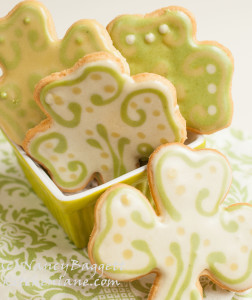 Welcome to “au naturel” Cookie Decorating 102. I say au naturel because the colors shown here all come from botanical ingredients, and not a single one is from synthetic food dyes. I say 102 because natural decorating 101 was already covered in a blog post recipe here (as well as in a really fun article that ran in the Washington Post.)
Welcome to “au naturel” Cookie Decorating 102. I say au naturel because the colors shown here all come from botanical ingredients, and not a single one is from synthetic food dyes. I say 102 because natural decorating 101 was already covered in a blog post recipe here (as well as in a really fun article that ran in the Washington Post.)The icing featured here is a green tea icing made with powdered matcha green tea. Depending on its freshness and quality, the color can range from fairly bright to a subdued mossy shade. Lots of people now enjoy matcha for its anti-oxidant power, but I’m most charmed by its hue and fresh, slightly vegetal taste. (The flavor goes nicely with almond in baked goods, btw.)
Let me stress that the natural color of even very vibrant matcha powdered tea is fragile. It will gradually fade and soften as the cookies stand. So, either plan to eat the cookies promptly after icing them, or pop them into the freezer until shortly before serving time. Freezing both holds the colors and keeps the marbled designs in the icing from blurring together.
 A post on how to create the patterned “marbled” look shown on the shamrocks, star, stocking, and candy cane in this post is here. A short, helpful video on the best way to roll out cookie dough is here.
A post on how to create the patterned “marbled” look shown on the shamrocks, star, stocking, and candy cane in this post is here. A short, helpful video on the best way to roll out cookie dough is here.
As the pics here show, depending on the brand, powdered green teas can range from a fairly vivid spring green to more muted, moss and gray-sage shades. So, if possible, examine the powders closely before you buy. The brighter, prettier tea shown here is the Teavana Imperial Matcha, which cost about $20 for a 1.4 ounce can. (The good news is that it will last a long time; as little as a couple pinches can tint a recipe of icing. Keep the container in the freezer.)
The less vibrantly hued variety, labeled only “Japanese Green Tea” in English (the brand name was in Japanese) I picked up in a local Asian grocery store for about $7 for a 1.05 ounce can. Another brand that is often recommended but that I haven’t yet tried is Stash.
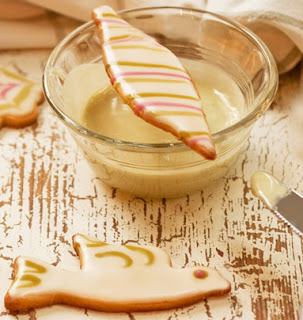 I actually like and use both of the teas shown for decorating, since the shades are quite different from one another and expand the overall palette. (The gray-green hues can be quite arresting when teamed up with other complementary colors, as the image at right reveals.)
I actually like and use both of the teas shown for decorating, since the shades are quite different from one another and expand the overall palette. (The gray-green hues can be quite arresting when teamed up with other complementary colors, as the image at right reveals.)
effective to create the same icing shade in different intensities—a small amount of powder yields a pale, creamy green, while ½ to 3/4 teaspoon produces a more saturated, bolder look. As you can see, using the two together, one as a background color and one to pipe on accents, adds instant drama and impact. To create a smooth surface where the piping blends in, add the icing while the bottom layer is still wet.
 As for flavor, both of these are pleasing, though in fact I actually
As for flavor, both of these are pleasing, though in fact I actuallyprefer the slightly more pronounced tea taste of the less expensive brand. However, my grandchildren don’t really care for the vegetal character of green tea, so the mildness of the Teavana version suits them much better. They also stick with the paler colored icings because they contain the least amounts of tea! BTW, I’ve heard that the taste of some low-end brands of green tea can be “off,”so bargain hunters beware when you shop.
corn syrup and meringue or egg white powder, but they are necessary for good results, so don’t leave either one out. The corn syrup promotes smooth flow and yields a glossy finish. The purchased meringue powder or dried egg white powder is important because it sets the colors and also keeps shades from
bleeding or fading together as the decorated cookies stand. Many discount department stores stock the Wilton brand of meringue powder with cake decorating supplies. Supermarkets and nutrition stores sometimes carry
a brand of pure dried egg whites in their baking aisle.
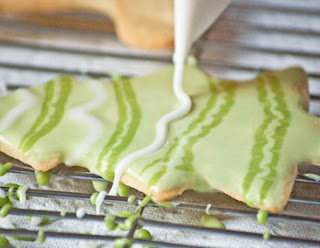
The almond or vanilla extract is entirely optional, though I think it adds a pleasant accent note to the green tea. Also, use either water or frozen (thawed) orange juice concentrate, as desired; the orange juice will produce a slightly more yellow-green shade.
Tip: The same recipe can be used to create a white icing; simply omit the green tea and vanilla (almond extract is colorless so can be used).Tip: If you create a shade of green tea that you decide should have a more intense color, thoroughly dissolve the extra green tea powder in a little warm water, then stir it into the bowl of icing.
For each batch of icing, thoroughly stir together the sugar, meringue or egg white powder, and green tea until thoroughly combined in a small deep bowl. Add the corn syrup, extract if using, then gradually stir in enough water to yield a fluid icing. Stir until very well blended, adding in more tea powder (blended with water first), water or powdered sugar to produce the color and consistency desired. Use the icings immediately or cover and refrigerate for up to a week (or freeze for up to a month. Let warm to room temperature before using, then stir well. Very thoroughly stir in a little water if the icings are too stiff to spread.For dye-free decorating in other seasons, see the Easter bunnies here and the Valentine’s heart cookies here.
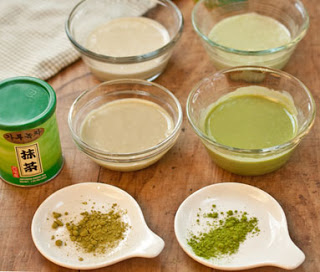

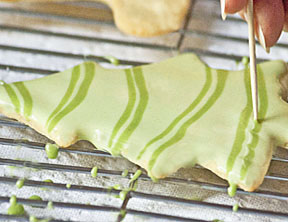

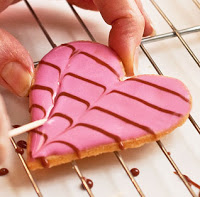

If you really must leave it out you can–it is included because it gives the icing a sheen and helps it flow and spread. But the recipe will still work if you omit it.
Love the green tea ice cream at my favorite sushi restaurant and now …cookie icing–sounds wonderful. One question, Nancy. Do you have a recipe for a cookie glaze that doesn't include corn syrup?
A lot of my family members have allergies, including me. I feel much more comfortable offering my grandkids icings that don't have commercial dyes in them, as I read that they can cause hyperactivity. Plus, I personally am allergic to red dyes.
Sorry but my previous comment came out garbled.
Thanks for this recipe. Unfortunately, many of the commercially produced icings, dyes and decors are manufactured in facilities that also process tree-nut products and my granddaughter is allergic. If I use the commercial stuff, I have to be a culinary Sherlock Holmes and many companies have multiple facilities so if one batch is TNF, the other might not be. This is a great alternative for colorful cookies that are safe for kids with allergies.
I love looking at the pictures of your cookies. I never would have thought of using green tea for creating icings. How did you think of it?
nifty idea, thanks for info on buying Matcha tea.